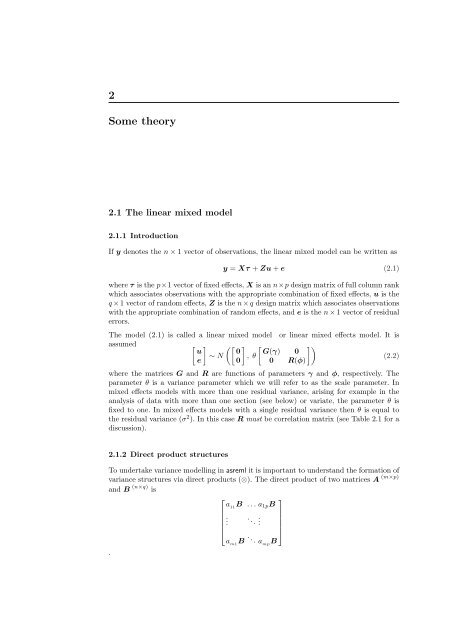- Page 1 and 2: Analysis of mixed modelsfor S langu
- Page 3 and 4: D.G. ButlerQueensland Department of
- Page 6: ContentsPreface . . . . . . . . . .
- Page 10 and 11: ContentsviiB Available variance mod
- Page 12 and 13: List of Figures1.1 Weekly body weig
- Page 14 and 15: 1.3 Data sets used 21.2.2 Help and
- Page 16 and 17: 1.3 Data sets used 41.3.2 Repeated
- Page 20 and 21: 2.1 The linear mixed model 8Direct
- Page 22 and 23: 2.2 Estimation 10There is a corresp
- Page 24 and 25: 2.2 Estimation 12where H ij = ∂ 2
- Page 26 and 27: 2.5 Inference for random effects 14
- Page 28 and 29: 2.6 Inference for fixed effects 16T
- Page 30 and 31: 2.6 Inference for fixed effects 18t
- Page 32 and 33: 3Fitting the mixed model3.1 Introdu
- Page 34 and 35: 3.3 Introducing the asreml function
- Page 36 and 37: 3.6 Getting help3.7 The asreml func
- Page 38 and 39: 3.8 Fixed terms 26na.method.Xkeep.o
- Page 40 and 41: 3.8 Fixed terms 28Summary of reserv
- Page 42 and 43: 3.10 Conditional factors: the at()
- Page 44 and 45: Table 3.2. Families and link functi
- Page 46 and 47: 3.15 Multivariate analysis 34R!trai
- Page 48 and 49: Source df F_inc F_con MSource df dd
- Page 50 and 51: 4.1.1 Specifying variance models in
- Page 52 and 53: 4.2 A sequence of structures for th
- Page 54 and 55: Σ = [σ ij ] :{σii = σ 2 , ∀i
- Page 56 and 57: 4.4 Variance model functions 44init
- Page 58 and 59: The Matérn class4.4 Variance model
- Page 60 and 61: 4.4 Variance model functions 48Chol
- Page 62 and 63: Required argumentsobj4.5 Rules for
- Page 64 and 65: 4.7 Constraining variance parameter
- Page 66 and 67: 5Genetic analysis5.1 IntroductionIn
- Page 68 and 69:
5.2 Pedigree, G-inverse objects and
- Page 70 and 71:
5.4 Using Pedigree and G-inverse ob
- Page 72 and 73:
6Prediction from the linear model6.
- Page 74 and 75:
Optional argumentslevels6.2 The pre
- Page 76 and 77:
6.2 The predict method 64The predic
- Page 78 and 79:
6.4 Complicated weighting 666.4 Com
- Page 80 and 81:
7The asreml class and related metho
- Page 82 and 83:
maxiter maximum number of iteration
- Page 84 and 85:
7.3 Methods and related functions 7
- Page 86 and 87:
7.3 Methods and related functions 7
- Page 88 and 89:
pedigree7.3 Methods and related fun
- Page 90 and 91:
7.3 Methods and related functions 7
- Page 92 and 93:
8Examples8.1 IntroductionThis secti
- Page 94 and 95:
8.2 Split Plot Design 82In this exa
- Page 96 and 97:
8.3 Unbalanced nested design 84[4,]
- Page 98 and 99:
8.3 Unbalanced nested design 86adju
- Page 100 and 101:
8.4 Sources of variability in unbal
- Page 102 and 103:
8.5 Balanced repeated measures 902
- Page 104 and 105:
8.5 Balanced repeated measures 92Ta
- Page 106 and 107:
8.5 Balanced repeated measures 94wh
- Page 108 and 109:
8.6 Spatial analysis of a field exp
- Page 110 and 111:
8.6 Spatial analysis of a field exp
- Page 112 and 113:
Variety predicted.value standard.er
- Page 114 and 115:
8.7 Unreplicated early generation v
- Page 116 and 117:
8.7 Unreplicated early generation v
- Page 118 and 119:
8.8 Paired Case-Control Study 106Th
- Page 120 and 121:
Terms added sequentially; adjusted
- Page 122 and 123:
8.8 Paired Case-Control Study 110[
- Page 124 and 125:
8.8 Paired Case-Control Study 112..
- Page 126 and 127:
8.9 Balanced longitudinal data - Ra
- Page 128 and 129:
8.9 Balanced longitudinal data - Ra
- Page 130 and 131:
8.9 Balanced longitudinal data - Ra
- Page 132 and 133:
8.9 Balanced longitudinal data - Ra
- Page 134 and 135:
A.3 Aliasing and singularities 122W
- Page 136 and 137:
Table B.1: Details of the available
- Page 138 and 139:
B Available variance models 126Deta
- Page 140 and 141:
ReferencesG. E. P. Box. Analysis of
- Page 142 and 143:
References 130W. W. Stroup, P. S. B
- Page 144 and 145:
Index 132F statistics, 17fa(,k), 49
















